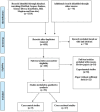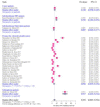Subtype distribution of Blastocystis sp. isolated from humans in Iran: a systematic review and meta-analysis
- PMID: 36762220
- PMCID: PMC9876770
- DOI: 10.22037/ghfbb.v15i4.2475
Subtype distribution of Blastocystis sp. isolated from humans in Iran: a systematic review and meta-analysis
Abstract
Aim: This systematic review and meta-analysis evaluated the subtyped Blastocystis sp. isolated from humans in Iran.
Background: Blastocystis sp. is an anaerobic intestinal protozoan that infects humans as well as domestic and wild animals, i.e. mammals, amphibians, reptiles, and arthropods.
Methods: A comprehensive search for papers published before April 2022 was undertaken utilizing English and Persian databases. The following MeSH keywords were used in the electronic search: (Blastocystis sp.) AND (molecular OR subtype) AND (prevalence OR epidemiology) AND Iran. The quality of the included studies was evaluated. Thereafter, a random-effects meta-analysis was conducted to estimate the pooled prevalence and odds ratios regarding the included studies.
Results: A total of 32 studies comprised of five case-control studies and 27 cross-sectional studies met the eligibility criteria. The overall pooled prevalence of subtyped Blastocystis sp. in Iran was estimated to be 10% (95% confidence interval: 6 to 15%). Eight subtypes of Blastocystis sp. (ST1- ST7 and ST9) were identified in our study, of which ST3 was the most common subtype (0.04); 0.02-0.07). The difference in subtypes between two case and control groups in reported studies was not significant, but the odds ratio of infection by ST3 (0.98; 95% CI, 0.30 to 3.20) was higher in cases.
Conclusion: The current systematic review showed that with the exception of ST8 and ST12, all human Blastocystis sp. subtypes reported in the world are found in different parts of Iran.
Keywords: Blastocystis; Iran; Meta-analysis; Subtype.
Conflict of interest statement
The authors declare no conflict of interest.
Figures






References
-
- Alfellani MA, Stensvold CR, Vidal-Lapiedra A, Onuoha ESU, Fagbenro-Beyioku AF, Clark CG. Variable geographic distribution of Blastocystis subtypes and its potential implications. Acta Trop. 2013;126:11–8. - PubMed
-
- Maleki B, Dalimi A, Majidiani H, Badri M, Gorgipour M, Khorshidi A. Parasitic infections of wild boars (Sus scrofa) in Iran: a literature review. Infect Disord Drug Targets. 2020;20:585–97. - PubMed
-
- Casero RD, Mongi F, Sánchez A, Ramírez JD. Blastocystis and urticaria: examination of subtypes and morphotypes in an unusual clinical manifestation. Acta Trop. 2015;148:156–61. - PubMed
-
- Javanmard E, Niyyati M, Ghasemi E, Mirjalali H, Aghdaei HA, Zali MR. Impacts of human development index and climate conditions on prevalence of Blastocystis: a systematic review and meta-analysis. Acta Trop. 2018;185:193–203. - PubMed
-
- Yoshikawa H, Iwamasa A. Human Blastocystis subtyping with subtype-specific primers developed from unique sequences of the SSU rRNA gene. Parasitol Int. 2016;65:785–91. - PubMed
Publication types
LinkOut - more resources
Full Text Sources
Miscellaneous
